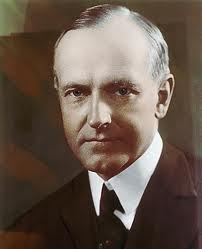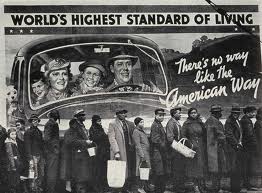 The American Dream is a twentieth century embodiment of the success-based work ethic with its emphasis on social mobility. The American Dream was founded on the presumption of equal opportunity, that America offered everyone the opportunity to improve their material standard of living if they were willing to take opportunities and work hard. Success was deserved, as was failure, and everyone was responsible for their own fate.
The American Dream is a twentieth century embodiment of the success-based work ethic with its emphasis on social mobility. The American Dream was founded on the presumption of equal opportunity, that America offered everyone the opportunity to improve their material standard of living if they were willing to take opportunities and work hard. Success was deserved, as was failure, and everyone was responsible for their own fate.
America’s reputation as a land of opportunity rested on its claim that the destruction of hereditary obstacles to advancement had created conditions in which social mobility depended on individual initiative alone. The self-made man, archetypical embodiment of the American dream, owed his advancement to habits of industry, sobriety, moderation, self-discipline, and avoidance of debt.
 The promise of the American Dream was promoted in the twentieth century by politicians and businessmen, despite increasing evidence to the contrary. In the 1920s Calvin Coolidge (pictured), then President of the US, argued that success was directly related to “the amount of hard work put into it”.
The promise of the American Dream was promoted in the twentieth century by politicians and businessmen, despite increasing evidence to the contrary. In the 1920s Calvin Coolidge (pictured), then President of the US, argued that success was directly related to “the amount of hard work put into it”.
During the Depression years the National Association of Manufacturers (NAM) and other organisations published advertisements extolling the leaders of industry as self-made men: “A typical advertisement featured a construction worker high on a steel girder looking down and waving at a man in a chauffeured limousine. The headline reads: ‘I knew him when he pushed a wheelbarrow,’ and the text purports to show that in America, every man and his offspring have an equal chance of success.”
A 1940s NAM pamphlet stated: “Your future is strictly up to you... Your opportunities will be limited only by your vision of what your future may become, your abilities and how you use them, your character and your determination.” Poverty and lack of education were obstacles that could be overcome by those who had “what it takes”. 
Children continued to learn at school about how various successful Americans had started from humble origins. In the 1940s the American Schools and Colleges Association, presented an annual “Horatio Alger Award” to businessmen whose “rise to success symbolizes the tradition of starting from scratch under our system of free competitive enterprise”.
 Throughout American history, according to economic measures, the standard of living has doubled about every 30 years. So to the extent that the American Dream meant better material living conditions through the generations, experience bore it out. This is no longer the case despite increasing wealth overall. People are realising, as Edward Kennedy pointed out in USA Today:
Throughout American history, according to economic measures, the standard of living has doubled about every 30 years. So to the extent that the American Dream meant better material living conditions through the generations, experience bore it out. This is no longer the case despite increasing wealth overall. People are realising, as Edward Kennedy pointed out in USA Today:
that economic growth and prosperity no longer benefit all Americans fairly... Superficial signs of prosperity abound—the stock market hitting record highs, inflation consistently low, unemployment down—but the prosperity is less than it seems. Americans are working harder and earning less. Their standard of living is stagnant or sinking... For the vast majority of families, the American Dream today has a sign over it that says, “Only the Wealthy Need Apply.”
Similarly, John Schwarz in his book Illusions of Opportunity notes that “the number of  Americans closed out of minimally adequate opportunity surpasses the total populations of the one hundred largest American cities combined.” Schwarz argues that whilst unemployment in the US is low, the number of jobs paying an adequate wage to support a family at a “minimally dignified” standard of living falls far short of the number who need them. And if the jobs are not there, neither is the opportunity that is supposed to be at the heart of the American Dream.
Americans closed out of minimally adequate opportunity surpasses the total populations of the one hundred largest American cities combined.” Schwarz argues that whilst unemployment in the US is low, the number of jobs paying an adequate wage to support a family at a “minimally dignified” standard of living falls far short of the number who need them. And if the jobs are not there, neither is the opportunity that is supposed to be at the heart of the American Dream.
In the face of the growing inequities it has been hard to maintain the American Dream. When surveyed, 57% of people said that the American Dream was out of reach for most families and more than two-thirds were concerned that their children would not live as well as they had. One third were concerned about losing their jobs soon. In another study 59% of blacks said that they thought the American Dream was impossible to achieve.
 To counter such perceptions, modern politicians still frantically promote the American Dream. Bill Clinton, as have other presidents before him, gave speeches on it. He claimed that if a person works hard and respects the law the only limit to their advancement is their own abilities. The House Republicans put out a book in 1995 entitled Restoring the American Dream which claimed that anyone in America could succeed whatever their skin colour or current income level. Restoring the American Dream was also the theme of the Republicans’ 1996 San Diego convention and of Presidential candidate Bob Dole’s speech.
To counter such perceptions, modern politicians still frantically promote the American Dream. Bill Clinton, as have other presidents before him, gave speeches on it. He claimed that if a person works hard and respects the law the only limit to their advancement is their own abilities. The House Republicans put out a book in 1995 entitled Restoring the American Dream which claimed that anyone in America could succeed whatever their skin colour or current income level. Restoring the American Dream was also the theme of the Republicans’ 1996 San Diego convention and of Presidential candidate Bob Dole’s speech.
In 1995 and 1996 a whole spate of books were published on how to promote and rejuvenate the American dream, including Reviving the American Dream by Alice Rivlin, The Success Ethic, Education and the American Dream by De Vitis and Rich, Facing up to the American Dream by Jennifer L. Hochschild, The American Dream by Edmond Morris, Recovering the American Dream Through the Moral Dimension of Work, Business and Money by Robert Wuthnow, The Good Life and Its Discontents by Robert J. Samuelson and Chasing After the American Dream by Thomas Kerr.